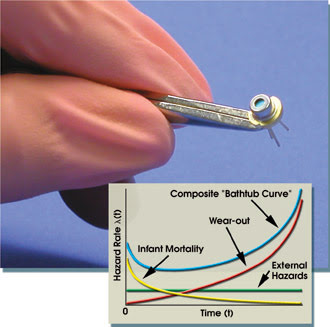Lawrence A. Johnson, ILX Lightwave Corp.
What does a simple $10 laser pointer have in common with a space-qualified optical transmitter link? In each case, the reliability of the semiconductor laser diode used is a key concern. The commercial success of a laser supplier thus rests largely on its ability to develop a robust manufacturing process that consistently produces reliable devices. This must be combined with the quantitative assurances that the company can provide to customers to prove the devices’ reliability. As a result, the past two decades have seen an evolution of reliability testing equipment to support the diverse development of these devices.
From a laser user’s point of view, the hazard rate characteristic curve for a population of typical devices will reveal many of the issues related to laser diode reliability. Hazard rate is defined as the probability of failure per unit time, at time t, given that the device has survived until time t.1 Infant mortality failures are often the result of defects introduced during the manufacturing process or intrinsic semiconductor defects.

In this typical hazard rate characteristic curve for a population of laser diodes, infant mortality failures often result from manufacturing defects. Throughout its life, a device will also face hazards from external factors such as current surges and electrostatic discharge.
External factors such as current surges and electrostatic discharge events create a constant hazard rate over the life of the device. In addition, wear-out failures in lasers are generally caused by the growth of nonradiative, optically absorbing defect regions.
Reliability test equipment
Laser diode reliability test equipment principally serves two purposes:
Production burn-in. Companies use this procedure to screen out devices that would fail early in their lifetimes and thereby to ensure that the remaining population of lasers will have a statistically acceptable level of reliability. Because of the impact of burn-in on manufacturing cost and cycle time, burn-in times of less than 100 hours are typical. Devices are screened on the basis of a shift in threshold current or in operating current required to achieve a nominal output power level.
Life test studies. Collecting laser lifetime data under carefully controlled operating conditions can help a company develop statistical models to predict laser lifetime under intended operating conditions. To obtain statistically meaningful data, life test studies normally involve dozens of lasers examined for periods of at least 1000 hours and often extending beyond a year.
Depending on the type and application of a laser diode, they involve the periodic measurement of a variety of parameters, including operating current, forward voltage, output power level, light-current-voltage characteristics and wavelength.
Laser diodes in modules such as butterfly packages require more extensive control and measurement capability during burn-in and life testing to accommodate the other internal components, such as monitor photodiode, thermistor and thermoelectric cooler. In both burn-in and life test studies, aging is accelerated by using elevated temperatures and drive currents.
A successful approach to laser diode reliability testing must take three primary factors into account:
Power level. Thermal management is a critical issue in all laser diode reliability test systems. Low-power lasers in TO-can packages can often be successfully accommodated in forced-air convection ovens that offer high density and low cost of testing. High-power laser diodes, such as those used as pump lasers or in materials processing applications, usually require water cooling and more complex fixture design, leading to higher cost of testing.
Package style. Complexity of both the fixture and the control and measure functions depends on laser diode package style. Chip-on-substrate packages require precision pogo pin-based fixtures. TO-can packages can be accommodated with simple heat sinks and sockets. Butterfly modules will most likely need only straightforward fixtures but will require relatively complex control and measure circuitry.
In situ vs. separate testing. When a large number of devices must be processed, it is frequently more economical to separate the testing from the high-temperature aging. In these cases, simple constant current, high-temperature aging racks or ovens will work in conjunction with a separate high-precision functional test system.
This approach involves periodically removing devices manually from the aging rack and inserting them into the functional test system. Although this offers the potential of low cost, it introduces a level of random measurement error that may be unacceptable in some applications.
Besides these primary considerations, reliability test equipment must provide high measurement precision, long-term stability, robust data management and high levels of protection for laser diodes.
Because of the wide variety of laser diodes, package styles, power levels and applications, it is not surprising that the associated reliability test equipment also varies widely. In a survey of laser diode manufacturers over the past year, ILX Lightwave Corp. of Bozeman, Mont., found that laser manufacturers build a majority of life test and burn-in equipment in-house, generally to achieve low cost, the flexibility to respond to a rapidly changing market and tight integration with existing manufacturing processes. However, as the market for laser diodes continues to grow, mature test equipment providers are bringing increasingly universal and cost-effective test solutions to the market.
Contact: Lawrence A. Johnson, president and CEO, ILX Lightwave Corp., Bozeman, Mont.; +1 (406) 586-1244; e-mail: [email protected].
Reference
1. Franklin R. Nash (1993). Estimating Device Reliability: Assessment of Credibility. Kluwer Academic Publishers, Boston.